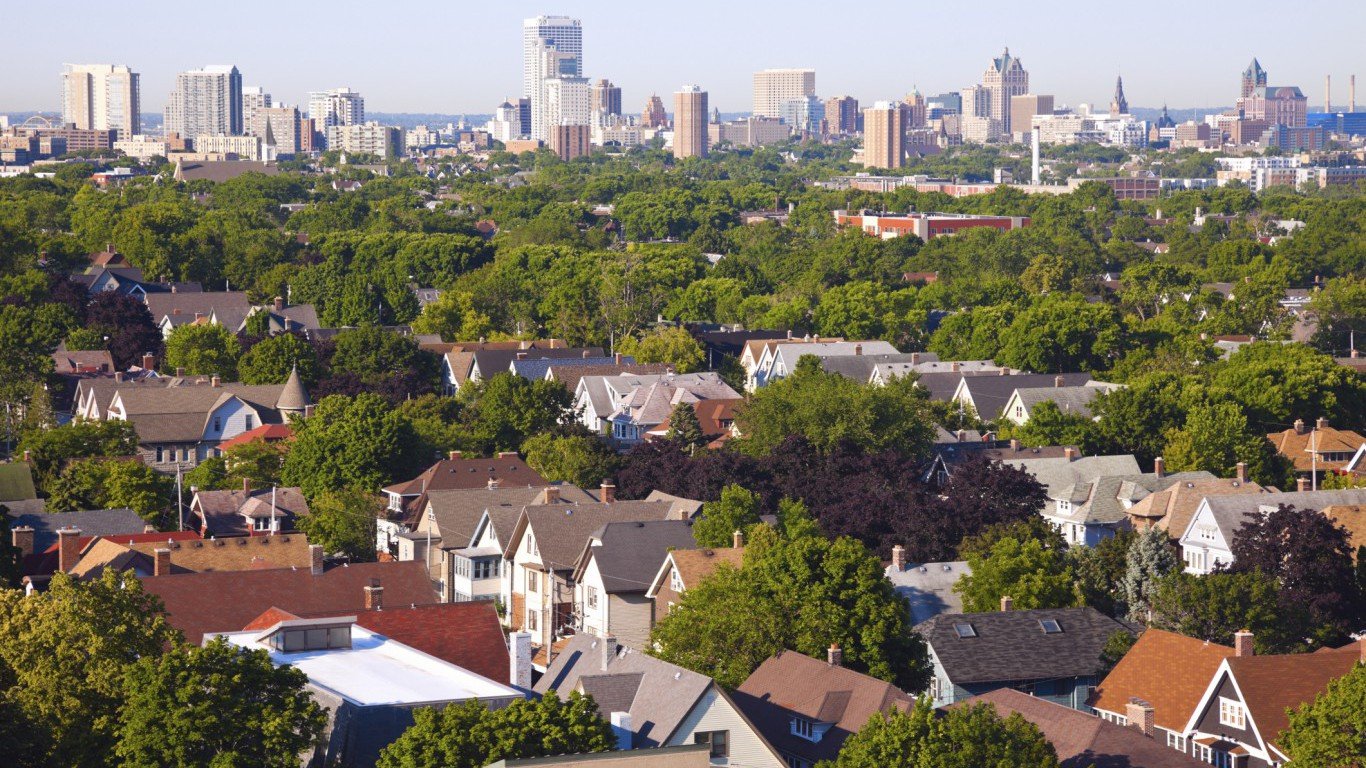

Taxes are used to fund government services, infrastructure, and public works projects and are an unavoidable cost of citizenship. While all Americans are subject to the same federal tax rates, the taxes they pay to their state and local governments varies depending on where they live — and these different taxes and tax rates can mean widely different tax burdens.
In some parts of the country, Americans pay as little as 6.5% of the state’s income per capita in taxes, while in others the average state and local tax burden is nearly double — as high as 12.7%.
Tax structure policy is one of the most powerful tools state and local governments have a their disposal. Certain tax structures incentivize certain behaviors and disincentivize others, often to achieve some defined outcome.
States and local municipalities can adjust tax policy in a variety of ways to boost economic activity, attract families and new residents, and take advantage of certain entrenched industries. In addition, states and local governments have certain budgetary obligations to take into account, such as road maintenance, school funding, and administrative costs, among others. All of these factors influence tax policy and the resulting share of income residents of a given region pay in taxes every year.
24/7 Wall St. reviewed each state’s tax burden — the portion of income that goes to state and local governments taxes per capita — from the report, “Facts & Figures 2018: How Does Your State Compare?” provided by tax policy research organization Tax Foundation.
Click here to see the states with the highest taxes.
Click here to see the states with the lowest taxes.
Click here to see our detailed findings and methodology.
States With the Highest Taxes

12. Massachusetts
> Taxes paid as pct. of income: 10.3%
> Income per capita: $64,235 (2nd highest)
> State income tax collections per capita: $2,115 (2nd highest)
> Property tax collections per capita: $2,258 (8th highest)
> General sales tax collections per capita: $892 (24th lowest)
New England is one of the most heavily taxed regions in the United States. In Massachusetts, an estimated 10.3% of taxpayer income goes to state and local taxes, above the 9.9% average across all states. One of the wealthiest states in the country, the typical Massachusetts household earns $75,297 a year, nearly $18,000 more than the typical American household. Due in part to high incomes, a larger than typical share of state and local tax revenue in Massachusetts comes from income tax. Income tax accounts for 33.6% of state and local revenue in Massachusetts compared to the 23.5% average across all states.
[in-text-ad]

11. Vermont
> Taxes paid as pct. of income: 10.3%
> Income per capita: $49,984 (20th highest)
> State income tax collections per capita: $1,171 (15th highest)
> Property tax collections per capita: $2,542 (5th highest)
> General sales tax collections per capita: $596 (11th lowest)
Vermonters pay an average of 10.3% of their income in state and local taxes every year, one of the highest shares of any state. Vermonters pay more in taxes on average than residents of any other state. The state collects an average of $4,950 per taxpayer annually, the most of any state and about $2,000 more than is typical across all states.
Property taxes account for a larger than typical share of state revenue in Vermont. An estimated 43.8% of state and local revenue comes from property taxes, well above the 31.1% average share across all states.

10. Oregon
> Taxes paid as pct. of income: 10.3%
> Income per capita: $45,399 (23rd lowest)
> State income tax collections per capita: $1,882 (6th highest)
> Property tax collections per capita: $1,404 (24th highest)
> General sales tax collections per capita: None
Oregon is one of just five states with no sales tax. Despite the break consumers receive in the checkout line, Oregon has one of the highest effective tax rates in the country. Taxpayers in the state pay about 10.3% of their income in non-federal taxes annually, more than in all but nine other states.
With fewer revenue streams than most states, a larger share than typical of state and local revenue in Oregon comes from personal income tax. An estimated 41.6% of state and local revenue comes directly from residents’ paychecks in the form of personal income tax, the largest share of any state and well above the 23.5% average across all states.

9. Rhode Island
> Taxes paid as pct. of income: 10.8%
> Income per capita: $50,427 (17th highest)
> State income tax collections per capita: $1,169 (16th highest)
> Property tax collections per capita: $2,339 (7th highest)
> General sales tax collections per capita: $921 (25th lowest)
Rhode Island is one of several New England states to rank among those with the highest effective tax burden. The high tax burden is driven in part by the state’s 7.0% sales tax — the second highest sales tax rate of among states. Property taxes are also high in Rhode Island. State and local authorities in Rhode Island collect the equivalent of $2,339 per person in property taxes annually, more than in all but six other states. Property taxes account for 43.2% of the state’s revenue, a larger share than in all but four other states.
Rhode Island has reduced corporate taxes in recent years in an attempt to spur economic growth. Corporations have benefitted from hundreds of millions of dollars in tax breaks in the last 10 years alone, and currently, per capita tax business tax collections are lower in Rhode Island than the average across all states.

8. Minnesota
> Taxes paid as pct. of income: 10.8%
> Income per capita: $52,038 (13th highest)
> State income tax collections per capita: $1,943 (5th highest)
> Property tax collections per capita: $1,534 (17th highest)
> General sales tax collections per capita: $1,011 (18th highest)
Minnesota taxes the purchase of products like cigarettes and alcoholic beverage more than most states, which likely contributes to the state’s higher that typical revenue revenue per capita from excise taxes. State and local excise governments collected in the equivalent of $849 per person in excise taxes in 2017, more than all but three other states.
Minnesota residents are also taxed more on their income than most Americans. The state collected nearly $2,000 per person in income tax alone in fiscal 2016, more than in all but four other states. Income tax accounts for 31.8% of state and local revenue in Minnesota, well above the 23.5% average across all states.
[in-text-ad-2]

7. Maryland
> Taxes paid as pct. of income: 10.9%
> Income per capita: $58,052 (5th highest)
> State income tax collections per capita: $1,414 (10th highest)
> Property tax collections per capita: $1,555 (16th highest)
> General sales tax collections per capita: $748 (20th lowest)
The typical household in Maryland earns $78,945 a year, the highest median income of any state. The strong tax base is a boon for state and local governments in Maryland. Some 37.6% of tax revenue in the state comes from income taxes, the second largest share of any state and well above the 23.5% average across all states.
Maryland also has a higher than typical excise tax rate on a number of products, including wine, beer, and cigarettes. Partially as a result, the state’s excise tax per capita collection of $816 in 2017 was higher than in all but three other states.

6. California
> Taxes paid as pct. of income: 11%
> Income per capita: $56,374 (6th highest)
> State income tax collections per capita: $2,055 (4th highest)
> Property tax collections per capita: $1,451 (21st highest)
> General sales tax collections per capita: $997 (21st highest)
An estimated 11% of income per capita in California goes to state and local governments in the form of taxes, a heavier tax burden than the 9.9% average across all states. Like many states with the highest tax burdens, a relatively large share of California’s revenue comes from personal income tax. Some 34.1% of state and local revenue comes directly out of workers’ paychecks, a higher share than in all but two other states. Not only is California heavily reliant on personal income, but also it collects far more than typical in corporate income. The state brought in $252 per capita in fiscal 2016 in corporate income tax, more than in all but six other states.

5. Illinois
> Taxes paid as pct. of income: 11%
> Income per capita: $51,817 (15th highest)
> State income tax collections per capita: $1,076 (22nd highest)
> Property tax collections per capita: $2,087 (9th highest)
> General sales tax collections per capita: $707 (18th lowest)
Homeowners in Illinois face a heavier tax burden than homeowners in nearly every other state. They pay the equivalent of 2% of their home value in state and local property taxes every year, the second highest rate of any state and nearly double the average across all states. The higher than average burden on homeowners means the state is more dependent than most on property taxes. An estimated 36.4% of state and local tax revenue in Illinois comes from property taxes compared to the 31.1% average across all states.
[in-text-ad]

4. Wisconsin
> Taxes paid as pct. of income: 11%
> Income per capita: $46,762 (24th highest)
> State income tax collections per capita: $1,297 (11th highest)
> Property tax collections per capita: $1,616 (14th highest)
> General sales tax collections per capita: $876 (23rd lowest)
In Wisconsin, 11% of residents’ income goes to state and local governments in the form of taxes, the fourth highest tax burden among states. Homeowners in the state are hit especially hard, paying an average of 1.8% of their home value in property taxes annually, the fourth highest effective property tax burden of any state.
In recent months, Wisconsin lawmakers have made efforts to reduce the tax burden residents shoulder. The state legislature recently issued a $122 million tax rebate and then approved a tax conformity measure expected to further lower the strain on taxpayers.

3. New Jersey
> Taxes paid as pct. of income: 12.2%
> Income per capita: $61,472 (3rd highest)
> State income tax collections per capita: $1,488 (7th highest)
> Property tax collections per capita: $3,074 (the highest)
> General sales tax collections per capita: $1,032 (16th highest)
Local governments in New Jersey heavily depend on property taxes. An estimated 46.1% of state and local tax revenue in the state comes from property taxes, the third highest share of any state and well above the average 31.1% share across all states. Homeowners in New Jersey pay an average of 2.2% of their home value, the largest share of any state. New Jersey residents not only pay the highest share in property taxes, but also they pay them on high property value — which further contributes to tax revenue to municipalities across the state. The typical home in New Jersey is worth $328,200, the fourth highest median home value of any state.
The state Senate unanimously approved a bill earlier this year in an effort to reduce the tax burden shouldered by homeowners. The bill retroactively allows those who made advance property tax payments in 2017 to receive more favorable deductions before the more burdensome new federal tax laws take effect.

2. Connecticut
> Taxes paid as pct. of income: 12.6%
> Income per capita: $69,311 (the highest)
> State income tax collections per capita: $2,106 (3rd highest)
> Property tax collections per capita: $2,847 (3rd highest)
> General sales tax collections per capita: $1,046 (15th highest)
Connecticut residents face the highest tax burden of any state in New England and the second highest burden in the country. The state government and municipalities collect the equivalent of $2,279 per person a year in income tax alone, the second highest income tax per capita of any U.S. state. Together with other taxes, the state collects the equivalent of $4,249 in taxes per per person per year, well above the average of $2,869 per capita across all states.
Despite the higher revenue, Connecticut borrows heavily. State and local debt per capita in fiscal 2015 topped $13,000, the third most of any state. Earlier this year, the state agreed to absorb the city of Hartford’s $540 million in debt to help avoid the need for the capital city to file for bankruptcy.
[in-text-ad-2]

1. New York
> Taxes paid as pct. of income: 12.7%
> Income per capita: $59,563 (4th highest)
> State income tax collections per capita: $2,345 (the highest)
> Property tax collections per capita: $2,697 (4th highest)
> General sales tax collections per capita: $682 (15th lowest)
The tax burden in New York is the highest of any state. On a per capita basis, 12.7% of New Yorkers’ income goes to state and local governments, well above the 9.9% average across all states. State and local governments collected some $8,722 per capita in taxes in fiscal 2015, the second most of any state. In an effort to stimulate the state’s economy, particularly upstate, lawmakers have been cutting, and in some cases eliminating, corporate income taxes. Still, at $211 in 2016, New York State’s per-capita revenue from corporate income tax is 10th highest among states.
While lower corporate tax rates may help stimulate the economy, it is doing little to reduce the state’s substantial debt, at least in the short term. Per-capita state and local debt in fiscal 2015 topped $17,000, by far the most of any state.
States With the Lowest Taxes

11. Oklahoma
> Taxes paid as pct. of income: 8.6%
> Income per capita: $42,692 (14th lowest)
> State income tax collections per capita: $764 (17th lowest)
> Property tax collections per capita: $678 (2nd lowest)
> General sales tax collections per capita: $630 (12th lowest)
Oklahoma has one of the lowest effective tax rates of any state in the country. Per-capita state and local tax revenue in Oklahoma total just $3,697, nearly $1,200 less than the average revenue across all states. Like many states where residents have a relatively small tax burden, state and local governments depend heavily on excise and other taxes apart from income or property tax. An estimated 23.5% of state government revenue comes from excise taxes, a far greater share than the 18.2% average across all states.
The low tax burden may have contributed to some budgetary problems. Recently, the state’s Republican-controlled legislature approved a tax increase to give public school teachers a pay raise and avoid a strike. Despite the measure, teachers across the state walked out in protest in early April. Currently, teachers in Oklahoma are among the lowest paid in the profession on average nationwide.
[in-text-ad]

10. Mississippi
> Taxes paid as pct. of income: 8.6%
> Income per capita: $35,484 (the lowest)
> State income tax collections per capita: $603 (12th lowest)
> Property tax collections per capita: $972 (13th lowest)
> General sales tax collections per capita: $1,105 (9th highest)
With a median household income of $41,754, Mississippi is the poorest state in the country. Due in part to a weak tax base, the state collects only $603 per capita in income tax, nearly $500 less than the average across all states. In the absence of strong income tax revenue, Mississippi relies heavily on sales tax. The state’s 7.0% sales tax rate is the second highest among states, and sales taxes accounts for 31.2% of the state’s total revenue, well above the 23.5% average across all states.
A fiscally conservative state, Mississippi not only has low taxes, but also relatively little borrowing. Per-capita debt in the state and across local governments totals just $4,738, the third lowest among states and about half the average per capita debt across all states.

9. South Carolina
> Taxes paid as pct. of income: 8.4%
> Income per capita: $39,517 (7th lowest)
> State income tax collections per capita: $780 (19th lowest)
> Property tax collections per capita: $1,130 (20th lowest)
> General sales tax collections per capita: $659 (13th lowest)
State and local governments in South Carolina collected $3,425 in tax revenue per person in fiscal 2015, the third lowest per capita collection amount of any state. As a percent of income per capita, South Carolinians pay less in taxes than residents of all but eight other states.
Earlier this year, state lawmakers moved forward on legislation that would create a flat income tax. If passed, the new law would change the current five tier structure that tops out at 7.0% to a single rate of 4.85%. South Carolina collected $780 in income tax per capita in 2016, slightly less than the $1,068 average per capita income tax revenue across all states.

8. Nevada
> Taxes paid as pct. of income: 8.1%
> Income per capita: $43,567 (19th lowest)
> State income tax collections per capita: None
> Property tax collections per capita: $959 (11th lowest)
> General sales tax collections per capita: $1,451 (3rd highest)
Nevada is one of only a handful of states with no income tax. With fewer revenue streams, the state relies more heavily on sales tax than most others. Nevada’s 6.85% sales tax rate is higher than that of most states, and much of the revenue derived from sales tax comes from tourists. Some 42.9 million people visited Las Vegas in 2016, spending some $35.5 billion. Sales taxes account for nearly 40% of state and local government revenue in Nevada, more than in all but three other states and nearly double the 23.5% average across all states.
[in-text-ad-2]

7. New Hampshire
> Taxes paid as pct. of income: 7.9%
> Income per capita: $55,954 (7th highest)
> State income tax collections per capita: $66 (9th lowest)
> Property tax collections per capita: $3,054 (2nd highest)
> General sales tax collections per capita: None
One of only a handful of states with no sales tax, state and local governments in New Hampshire depend much more on property taxes than is typical. Homeowners in the state pay an average of about 2% of their home value in non-federal property taxes annually, a higher share than in all but two other states. Partially as a result, some 65.7% of state and local revenue come from property taxes, by far the largest share of any state and more than double the average across all states.
Though it taxes capital gains, New Hampshire is also one of only a handful of states with no personal income tax. It does, however, collect heavily on corporate taxes. On a per capita basis, New Hampshire collected $525 in corporate taxes in fiscal 2016, more than any other state.

6. Louisiana
> Taxes paid as pct. of income: 7.6%
> Income per capita: $42,298 (13th lowest)
> State income tax collections per capita: $612 (13th lowest)
> Property tax collections per capita: $869 (8th lowest)
> General sales tax collections per capita: $680 (14th lowest)
On a per capita basis, Louisiana residents pay just 7.6% of their income to state and local governments in the form of taxes, tied as the fifth smallest share of any state. The Louisiana state government collects just $1,987 per capita annually, less than all but five other states. Currently, Louisiana levies a 20 cent tax on every gallon of gas sold in the state, far less than in the majority of other states. Recently, state lawmakers struck down a bill that would have allowed local municipalities to levy an additional tax on gasoline in order to fund road and bridge repairs.
Like many states with low tax burdens, Louisiana is relatively poor. The typical household in the state earns just $45,146 a year, about $12,500 less than the median household income nationwide.

5. Texas
> Taxes paid as pct. of income: 7.6%
> Income per capita: $46,274 (25th highest)
> State income tax collections per capita: None
> Property tax collections per capita: $1,731 (13th highest)
> General sales tax collections per capita: $1,151 (5th highest)
Texas is one of only a few states with no income tax. Instead, the state and local governments rely more on property and sales tax. Property taxes account for 42.0% of state and local revenue, and sales taxes accounts for 36.3%, well above the averages across all states of 31.1% and 23.5%, respectively.
With large oil and natural gas deposits, Texas is the largest energy producer among states, and taxes on resource extraction are a boon for state coffers. The state collects a 4.6% business tax on oil and a 7.0% tax on natural gas. Oil and gas production accounted for some $3 billion in state revenue in 2017 alone.
[in-text-ad]

4. Tennessee
> Taxes paid as pct. of income: 7.3%
> Income per capita: $43,326 (18th lowest)
> State income tax collections per capita: $49 (8th lowest)
> Property tax collections per capita: $863 (7th lowest)
> General sales tax collections per capita: $1,054 (13th highest)
State and local governments in Tennessee collected the equivalent of $3,268 in taxes in fiscal 2015, the second lowest per-capita tax revenue figure of any state. As is often the case in states with low taxes, Tennessee relies heavily on sales tax revenue to meet budget obligations. Some 40.7% of state and local revenue in fiscal 2015 came from sales taxes, the second highest proportion of any state. Strong sales tax revenue is partially attributable to Tennessee’s 7% sales tax, the second highest sales tax of any state.
A fiscally conservative state, Tennessee not only levies low taxes, but also borrows little. The state’s per capita debt of $913 is the lowest of any state in the country.

3. Wyoming
> Taxes paid as pct. of income: 7.1%
> Income per capita: $55,116 (9th highest)
> State income tax collections per capita: None
> Property tax collections per capita: $2,347 (6th highest)
> General sales tax collections per capita: $1,097 (11th highest)
Wyoming’s tax code is far less burdensome for the typical resident than that of nearly every other state. Accounting for about 40% of all U.S. coal production, Wyoming is the nation’s largest coal producer. Coal production is not just a boon for the economy, but also to state and local government coffers. Resource extraction accounted for over $2.1 billion in tax revenue in 2016.
Due in part to taxes on the states natural resources, Wyoming can meet budgetary obligations with no revenue from income tax. Wyoming is one of several resource-rich states, including Alaska and Texas, that levies no income tax. Consumers in Wyoming also catch a tax break on certain products, as the state levies no taxes on wine or spirits and has the lowest excise tax on beer of any state.

2. South Dakota
> Taxes paid as pct. of income: 7.1%
> Income per capita: $47,834 (22nd highest)
> State income tax collections per capita: $00 ()
> Property tax collections per capita: $1,381 (24th lowest)
> General sales tax collections per capita: $1,124 (6th highest)
South Dakota is one of only a few states with no corporate or personal income tax. Consequently, state and local governments in South Dakota depend heavily on sales taxes to meet budgetary obligations. Some 40.5% of the state’s tax revenue comes from sales taxes, the third largest share of any state. South Dakota collected $2,028 per capita in taxes in fiscal 2016, one of the lowest population-adjusted tax revenues in the country.
With insufficient tax collections, South Dakota has to borrow to meet budgetary obligations. The state’s debt of $3,828 per capita is higher than in a majority of states.
[in-text-ad-2]

1. Alaska
> Taxes paid as pct. of income: 6.5%
> Income per capita: $55,646 (8th highest)
> State income tax collections per capita: None
> Property tax collections per capita: $2,001 (11th highest)
> General sales tax collections per capita: None
Largely because Alaska levies no sales or income tax, the state has the lowest tax burden as a share of income per capita of any state. Because the state has fewer revenue streams, a larger than typical share of Alaska’s budget funding comes from property taxes and corporate income tax. Some 57.2% of state and local revenue came from property taxes in fiscal 2015, and 8.8% came from corporate income tax, respectively, the second and third largest shares among states.
A low tax burden on residents does not mean the state has limited revenue. Alaska has one of the largest proved oil reserves of any state and levies a 35% tax on all oil and gas produced in the state. This contributed to Alaska’s high total revenue per capita of $10,418 in fiscal 2016, the second highest population-adjusted revenue figure of any state.
Detailed Findings & Methodology
The states with the lowest tax burdens are often fiscally conservative with fewer budgetary obligations. As a result, not only are taxes low in those states, but also the per-capita debt. Total state and local government debt per capita across all states averaged $9,327 in fiscal 2015. Only three of the 11 states with the lowest tax burden borrowed more than that.
On the other hand, states with the highest tax burdens are often also bigger spenders, and as a result borrow more. Despite collecting more of residents’ income, eight of the 12 states with the largest tax burdens also have more debt per capita than the average across all states.
Aside from budgetary obligations, the local economy also heavily influences state and local tax codes. For example, states with strong tourism industries, like Florida and Nevada, capitalize on tourist spending with higher sales tax rates. An estimated 34.2% of state and local tax revenue in Florida and 39.7% in Nevada come from sales taxes, more than in most states and well above the 23.5% average across all states. Partially because of revenue generated through tourism, Nevada ranks among the states with the lowest tax burdens and is one of only a handful of states with no individual income tax.
In resource-rich states, like Alaska, Texas, and Wyoming, governments tax resource extraction, which in turn eases residents’ tax burden. Due in part to revenue generated by coal extraction in Wyoming and oil production in Alaska and Texas, neither of these states levies a personal income tax, and each ranks among the states with the lowest effective tax burdens.
In contrast, states where residents bear the heaviest tax burden rely heavily on property and and personal income tax. In Maryland, for example, the typical household earns $78,945 a year, the highest median income of any state. With a strong tax base, income taxes account for 37.6% of state and local revenue in Maryland, the second highest share of any state. The overall tax burden in Maryland is higher than in all but six other states.
Similarly, the typical home in New Jersey is worth $328,200, well above the $205,000 median home value nationwide. The state’s high property values translate to high government revenue. Per-capita property tax revenue in the Garden State amounted to $3,074 in fiscal 2015, the most of any state. Partially as a result, New Jersey has the third highest tax burden of any state.
To identify the states with the highest and lowest tax burdens, 24/7 Wall St. reviewed state and local tax burdens as a share of state residents’ income in fiscal 2012 provided by the Tax Foundation. Personal income per capita for each state is for 2016 and came from the U.S. Bureau of Economic Analysis. State individual income tax collections per capita are for fiscal 2016; state and local property tax collections per capita are for fiscal 2015; state general sales tax collections per capita are as of January 1, 2018; and all from the “Tax Foundation’s Facts & Figures 2018: How Does Your State Compare?” report. Sales tax rates, including combined rates, gasoline excise tax rates, cigarette excise tax rates, spirit and wine excise tax rates are as of January 1, 2018 and were also provided by the Tax Foundation. We also considered economic data including poverty rates and homeownership rates from the U.S. Census Bureau’s 2016 American Community Survey.
Sponsored: Want to Retire Early? Here’s a Great First Step
Want retirement to come a few years earlier than you’d planned? Or are you ready to retire now, but want an extra set of eyes on your finances?
Now you can speak with up to 3 financial experts in your area for FREE. By simply clicking here you can begin to match with financial professionals who can help you build your plan to retire early. And the best part? The first conversation with them is free.
Click here to match with up to 3 financial pros who would be excited to help you make financial decisions.
Thank you for reading! Have some feedback for us?
Contact the 24/7 Wall St. editorial team.
 24/7 Wall St.
24/7 Wall St.
